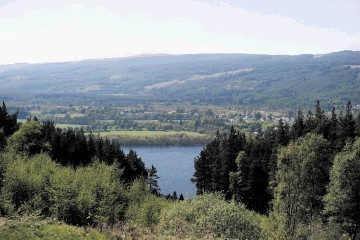
Plans have been unveiled for a new pumped storage hydro scheme on the south side of Loch Ness.
Developers say the 300MW project near Whitebridge will contribute to efforts to tackle climate change.
They also believe the development would be relatively unobtrusive as it plans to use existing natural features in the landscape.
If approved, it would be the third pumped storage scheme operating, or in the pipeline, at Loch Ness.
Statera Energy is to hold a series of exhibitions across the area from this month to outline its plans.
It is also in talks with Scottish Canals about the future management of water levels in Loch Ness.
Statera says its project could work in addition to SSE’s existing pumped hydro scheme at Foyers and the ILI Group’s Red John development which was approved this year.
It is claimed the proposed scheme would potentially save up to 500,000 tonnes of CO2 every year by displacing fossil fuel generation.
It would inject £20 million into the local economy each year for up to four years.
Up to 300 jobs would be created during construction and there would be six to eight permanent jobs in operations.
Pumped hydro is said to be one of the most sustainable forms of energy generation.
At times of excess generation, the system uses surplus electricity to pump water from a lower reservoir to a higher reservoir.
The water is stored in the higher reservoir and released when there is a shortage of supply, generating electricity using a hydro turbine.
The Statera project would use Loch Kemp as an upper reservoir and Loch Ness as the lower reservoir.
The water level of Loch Kemp would be raised by about 15%, approximately 90ft.
Andrew Troup of Statera Energy said this offers a number of benefits.
He said: “This makes the project less visible overall as we can make use of the existing natural features while increasing water levels in Loch Kemp.
“By reducing the requirement for large dams, we will reduce the need to import materials on to site so traffic movements will be minimal.
“It’s a good site for a pumped storage hydro scheme which is much needed to stabilise the grid and make energy supplies more secure.”
The scheme would be located within the Dell Estate, about eight miles to the north-east of Fort Augustus.
Statera says the three Loch Ness scheme are needed, with National Grid’s 2021 Future Energy Scenarios publication estimating a need for 15,000-40,000MW of additional storage, comprising pumped hydro, batteries and compressed and liquid air, by 2050.
Catherine Topley, CEO of Scottish Canals, added: “As the Caledonian Canal approaches its 200th anniversary in 2022, we are pleased to have been invited to explore the potential of diversifying and enhancing our assets to support the challenges faced by today’s society.
“As public assets we continue to explore a range of opportunities to build upon our existing legacy for future generations.”
The public exhibitions will be open between 12.30pm-7.30pm at Glenmoriston Millennium Hall, Invermoriston, on November 30, Fort Augustus Village Hall on December 1 and the Wildside Centre, Whitebridge on December 2.
Mr Troup added: “We would urge people to come along and find out more.
“This is the first exhibition to allow us to outline the broad plan, the consultation process and what we plan to consider in our Environmental Impact Assessment.
“We will then hold a second exhibition incorporating feedback, before making our application at the end of 2022.”
